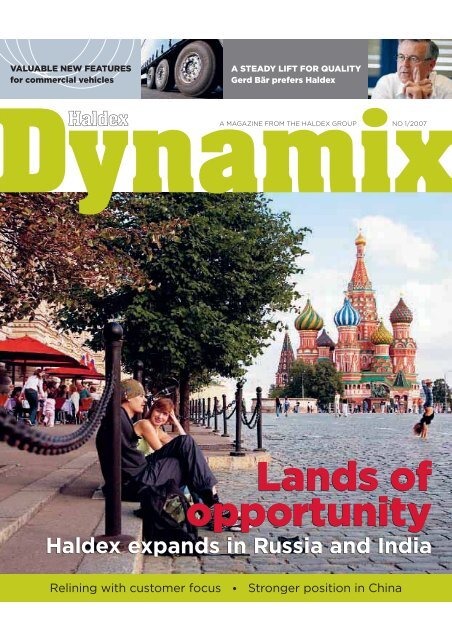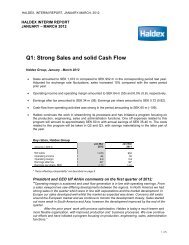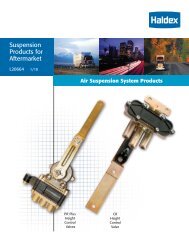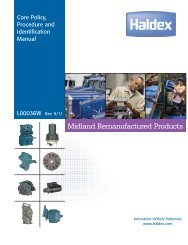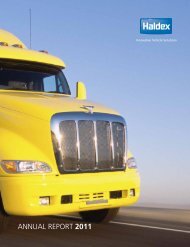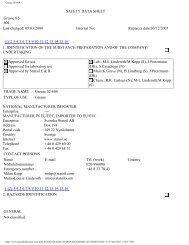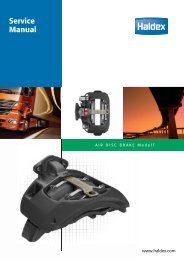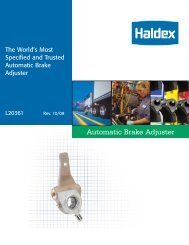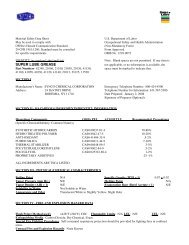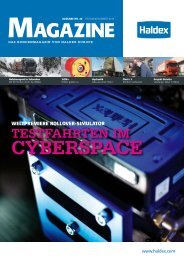Intelligence for All Wheel Drive - Haldex
Intelligence for All Wheel Drive - Haldex
Intelligence for All Wheel Drive - Haldex
You also want an ePaper? Increase the reach of your titles
YUMPU automatically turns print PDFs into web optimized ePapers that Google loves.
VALUABLE NEW FEATURES<br />
<strong>for</strong> commercial vehicles<br />
<strong>Haldex</strong><br />
A STEADY LIFT FOR QUALITY<br />
Gerd Bär prefers <strong>Haldex</strong><br />
A MAGAZINE FROM THE HALDEX GROUP NO 1/2007<br />
Lands of<br />
opportunity<br />
<strong>Haldex</strong> expands in Russia and India<br />
Relining with customer focus • Stronger position in China
�Content<br />
News<br />
IN SHORT. <strong>Haldex</strong> participates in a EU-supported<br />
project to improve traffic safety. 4<br />
STRONGER POSITION. The <strong>Haldex</strong> acquisition<br />
of Runguang Hydraulics provides the company<br />
access to the Chinese mobile hydraulics<br />
market. 22<br />
Customer first<br />
A TAIL OF SUCCESS. Gerd Bär GmbH dominates the<br />
field of mobile lifting systems. The company<br />
has chosen <strong>Haldex</strong> as sole supplier of<br />
crucial component. 6<br />
<strong>Haldex</strong> people<br />
WITNESS TO HISTORY. During his 33<br />
years in the company, Anders Loggert<br />
has seen — and been part of<br />
— <strong>Haldex</strong>’s rise into one of Sweden’s<br />
corporate success stories. 11<br />
<strong>Haldex</strong> Dynamix is a magazine published by the <strong>Haldex</strong> Group, Biblioteksgatan 11, Box 7200, SE-103 88 Stockholm, Sweden.<br />
Editor in chief: Lena Olofsdotter. Editorial services, design and prepress: Appelberg, Box 7344, SE-103 90 Stockholm Sweden, Tel + 46-8-406 54 00.<br />
Managing editor: Anne Hammarskjöld. Editorial commitee: Mats Kälvemark, Sherilyn Hensaw, Thomas Holm, Ulf Herlin, Mårten Lund, Diana Spieler, Steve Zarembski.<br />
Copy editing: Valerie Mindel. Graphic design: Lena Palmius. Print: Trydells Tryckeri, Laholm, Sweden. Cover photo: Ina Agency Press.<br />
Subscription: info@haldex.com or Fax + 1 (816) 891 9447. <strong>Haldex</strong> Dynamix is published twice a year, in Chinese, English, German and Swedish.<br />
2 <strong>Haldex</strong> Dynamix 1/2007<br />
11<br />
18<br />
Expertise<br />
JOINED FORCES. Dual brake discs, a fixed calliper<br />
brake and unbeatable maintenance are some of<br />
the features of SKF and <strong>Haldex</strong>’s new wheel <strong>for</strong><br />
commercial vehicles. 12<br />
THE HALDEX WAY. The Grand Rapids, Michigan,<br />
brake shoe relining plant in the United States puts<br />
listening to the customer at the center of its operations.<br />
24<br />
Features & Friends<br />
12<br />
NO BRAKES ON INDIA. In the wake of new<br />
safety regulations, India is facing a huge<br />
need <strong>for</strong> automatic brake adjusters. <strong>Haldex</strong><br />
India is ready to fill that need. 16<br />
ECONOMIC BOOM. Business is booming in<br />
both Russia and India, and <strong>Haldex</strong> is there to<br />
take advantage of the opportunities. 18<br />
DO IT LIKE TOYOTA. By eliminating waste, Japan’s<br />
Toyota has shown the world how to produce<br />
cars with maximum profitability. 23<br />
24<br />
www.haldex.com
6<br />
<strong>Haldex</strong> is preferred supplier of a key hydraulic component to Bär,<br />
Europes leading supplier of high quality mobile lifting systems.<br />
When the environment,<br />
safety and vehicle<br />
dynamics drive demand<br />
THE STRATEGIC SIGNIFICANCE OF HALDEX’ engagement in<br />
China, India and other so-called emerging markets is rapidly increasing.<br />
For example, the market in China <strong>for</strong> wheel-loaders is as large<br />
as that in the rest of the world. The acquisition of Runguan Hydraulics<br />
(see article on page 22) further rein<strong>for</strong>ces <strong>Haldex</strong> position as the<br />
leading supplier of hydraulics products to the Chinese construction<br />
equipment industry. <strong>Haldex</strong> Hydraulics (Qingzhou) Co. Ltd. will<br />
manufacture hydraulic pumps, valves and cylinders <strong>for</strong> different types<br />
of construction plant such as wheel loaders and excavators.<br />
Alongside the very positive developments in China, India is becoming<br />
an increasingly more important market <strong>for</strong> <strong>Haldex</strong>. In April 2007,<br />
new legislation was introduced here with regard to automatic brake<br />
adjustment systems <strong>for</strong> commercial vehicles. With 60 percent of the<br />
global market, <strong>Haldex</strong> is world leader in automatic brake adjusters<br />
and is at present starting up local production to ensure deliveries to<br />
commercial vehicle manufacturers in India. It is interesting to note<br />
that demand is being driven by legislation. Legislation is even being<br />
discussed in China and this could provide new opportunities <strong>for</strong> <strong>Haldex</strong><br />
and our partners in the commercial vehicle and construction equipment<br />
industries.<br />
In the usa, we can also see extensive and promising opportunities<br />
<strong>for</strong> <strong>Haldex</strong>. Environmental legislation is being tightened with regard<br />
to engine emission limits. This has meant an increase in demand <strong>for</strong><br />
Alfdex, the very successful crankcase gas cleaning system developed by<br />
<strong>Haldex</strong> in close cooperation with Alfa Laval. <strong>Haldex</strong>’ crankcase gases<br />
cleaning system has also been tested this spring on truck engines. The<br />
automotive industry has shown great interest in this technology that<br />
uses a variable pump, Varivent, which recirculates exhaust gases in diesel<br />
engines. egr, Exhaust Gas Recirculation, is in great demand in the<br />
usa but is also used by Scania and man, among others, in Europe.<br />
Also, <strong>Haldex</strong>’ Traction Systems Division is rising to meet large-scale<br />
challenges – deliveries of fourth generation 4wds are now being prepared.<br />
These will be used, among other things, in Volkswagen’s new<br />
Tiguan. We are also establishing a new factory in Mexico, with a delivery<br />
start to a new North American customer planned <strong>for</strong> 2008.<br />
<strong>Haldex</strong> mission values focus on safety, the environment and vehicle<br />
dynamics. Guided by these, we have built up a strong plat<strong>for</strong>m as a<br />
supplier to leading automotive manufacturers in Europe and the usa.<br />
It is both gratifying and exciting that similar quality concepts are now<br />
being demanded in the world’s fastest growing economies. <strong>Haldex</strong> is<br />
well prepared to meet these immense and stimulating<br />
challenges.<br />
Joakim Olsson<br />
Managing Director<br />
and Group ceo<br />
www.haldex.com 1/2007 <strong>Haldex</strong> Dynamix 3
�News<br />
Photo iStockphoto<br />
Tougher Japanese<br />
Fuel-Economy Limits<br />
The Japanese ministries of Industry<br />
and Transport, have agreed on<br />
new fuel efficiency standards. The<br />
ministries plan to revise regulations<br />
this summer. Cars, including diesel<br />
engine models, will be required to<br />
run 16.8 kilometres on one litre of<br />
fuel under a specific driving mode.<br />
The figure is 23.5% more than an<br />
average of 13.6 km/l in 2004. The<br />
2015 targets <strong>for</strong> small buses and<br />
trucks are set at 8.9 km/l and 15.2<br />
km/l, respectively, up 7.2 % and 12.6<br />
respectively from 2004 averages of<br />
8.3 km/l and 13.5 km/l.<br />
4 <strong>Haldex</strong> Dynamix 1/2007<br />
<strong>Haldex</strong> involved in EU<br />
traffic safety project<br />
THE 3-YEAR SPARC (Secure Propulsion using Advanced Redundant Control) project,<br />
a joint EU/industry-funded ef<strong>for</strong>t to improve traffic safety through advanced technology,<br />
was concluded this summer with a major presentation to the EU Commission<br />
on July 16 and to the vehicle industry on July 17, in Papenburg, Germany. About 400<br />
top managers and key figures from the vehicle industry attended the industry<br />
presentation. The project, which began in 2004, was coordinated by DaimlerChrysler<br />
and included 27 other representatives from the European vehicle industry. <strong>Haldex</strong><br />
has provided Electro Mechanical Brakes (EMB) <strong>for</strong> one of the trucks in the project as<br />
well as a complete control system, including EMB and Electronic Air Suspension, <strong>for</strong><br />
one of the project trailers. The purpose of SPARC was the creation of a predictive,<br />
rather than reactive, hazard detection system.<br />
For further in<strong>for</strong>mation on SPARC, visit: http://www.sparc-eu.net<br />
Photo INA Agencypress<br />
China plans <strong>for</strong><br />
Jatropha Biodiesel<br />
THE STATE FORESTRY ADMINISTRATION OF CHINA plans to plant 13 million<br />
hectares (an area the size of England) with Jatropha trees <strong>for</strong> biodiesel.<br />
Jatropha is currently grown on around 2 million hectares across the<br />
country. The <strong>for</strong>est, mostly spread over southern China, is expected eventually<br />
to produce nearly 6 million tons (6,8 billion litres) of biodiesel every<br />
year.<br />
www.haldex.com
Time <strong>for</strong> greener Formula 1<br />
The environmental requirements<br />
imposed on Formula 1 racing are<br />
being tightened and the end is<br />
drawing near <strong>for</strong> the considerable<br />
carbon dioxide emissions produced<br />
by Formula 1 cars. In 2011, new rules<br />
will be in effect <strong>for</strong> a greener racing<br />
environment.<br />
THE HEAD OF THE FIA car racing organization, Max<br />
Mosley suggests there will be new opportunities <strong>for</strong> racing<br />
teams and race car designers when the rules change<br />
in 2011. Bio fuels, energy recycling, limited fuel allocation<br />
and smaller cylinder volumes – perhaps even hybrid<br />
engines – will be used to decrease carbon dioxide emissions<br />
be<strong>for</strong>e Formula 1 falls into disrepute in the face of<br />
environmentally conscious public opinion.<br />
The designers are aware that the highest category <strong>for</strong>mula<br />
race cars are environmental bad guys and that the<br />
potential exists to reduce emissions. An 800 horse power<br />
Formula 1 car releases about 1,500 grams of carbon dioxide<br />
per kilometer on the track. In comparison, average<br />
emissions <strong>for</strong> cars today is 170 grams and the eu recently<br />
set a limit of 130 grams by 2012.<br />
Technology<br />
can save lives<br />
Safety oriented Intelligent Transport<br />
Systems, ITS, such as Adaptive<br />
Cruise Control and Intelligent Speed<br />
Assistance can save reduce casualties<br />
(fatalities and injured) by 40<br />
percent according to a report from<br />
the Dutch Institute <strong>for</strong> Road Safety<br />
Research. The report points out<br />
Intelligent Speed Assistance as the<br />
most promising new technology in<br />
terms of potential impact on safety.<br />
ALFDEX TAKES OFF<br />
ORDERS FOR THE ALFDEX OIL/MIST SEPARATOR have increased dramatically<br />
since last December. The main impetus <strong>for</strong> increased production is environmental<br />
legislation that is now taking effect. “In 2005, environmental laws took effect<br />
in Japan. In January<br />
2007, they took effect<br />
in the United States. In<br />
2008 and 2009, they<br />
will take effect in the<br />
EU,” says Mats Ekeroth,<br />
Alfdex president. Recent<br />
Photo iStockphoto<br />
‘‘<br />
In 2005, environmental laws took<br />
effect in Japan. In January 2007,<br />
they took effect in the United States.<br />
In 2008 and 2009, they will take<br />
effect in the eu.<br />
Mats Ekeroth, Alfdex president’’<br />
attention on greenhouse<br />
gases and global<br />
warming has not had an<br />
immediate impact on<br />
business, says Ekeroth.<br />
“Even without the ‘Al Gore effect,’ demand <strong>for</strong> our separator is up because of<br />
existing laws. Catalytic regulations, <strong>for</strong> example, are on the rise everywhere.”<br />
But as governments respond to new pressure, they may further tighten environmental<br />
legislation, which may result in additional demand <strong>for</strong> Alfdex, whose<br />
customers are large truck manufacturers.<br />
www.haldex.com 1/2007 <strong>Haldex</strong> Dynamix 5
A lift<br />
<strong>for</strong> quality and logistics<br />
<strong>for</strong> quality and logistics<br />
Gerd Bär is a man with his own way of doing<br />
things, a fact that has helped drive Gerd Bär<br />
GmbH to the top in the fi eld of a mobile lifting<br />
systems. The company has chosen <strong>Haldex</strong> as<br />
sole supplier of crucial components.<br />
Text Michael Lawton Photos Thomas Müller<br />
Entrepreneur Gerd Bär is a typical product of the<br />
Swabian region of Germany: He’s a bit stubborn, a<br />
bit conservative, very hardworking and driven. He<br />
started out running his father’s fl our mill. When<br />
he had turned it into a profi table business, he handed it<br />
over to his brother. Following his education, he went to<br />
work <strong>for</strong> a company that made lifts <strong>for</strong> the backs of trucks,<br />
and when the management wouldn’t let him get involved<br />
in policy making, he went off and founded his own company,<br />
Gerd Bär GmbH.<br />
Despite the fact that he has now retired from active<br />
involvement in Bär, Gerd Bär is still the spirit behind the<br />
company, which has just celebrated its 25th anniversary.<br />
Rolf Petermann-van den Berg, the company’s commercial<br />
director, says, “We are a very young leadership team, but<br />
we are all deeply infl uenced by [Gerd Bär].” The company<br />
makes the Bär Cargolift mobile lifting system and is the<br />
market leader in Germany, Poland, the Czech Republic and<br />
Russia. �<br />
6 <strong>Haldex</strong> Dynamix 1/2007 www.haldex.com
‘‘<br />
We also got rid of the need <strong>for</strong> welding<br />
– first because welders are rare and<br />
expensive<br />
’’<br />
and second because you then<br />
need to treat the joint with new rustproofing.<br />
Gerd Bär<br />
www.haldex.com 1/2007 <strong>Haldex</strong> Dynamix 7
Bär was the first mobile lifting system producer to offer<br />
aluminum plat<strong>for</strong>ms as standard. Bär was also the first<br />
company to offer a two-year guarantee on their steel<br />
parts, when six months was standard.<br />
Gerd Bär himself is known as an innovator in a fairly<br />
conservative environment: “I have made an impression on<br />
the industry,” he says, refl ecting on his career. “Others have<br />
followed me.”<br />
From the start, Bär was the fi rst company to offer aluminum<br />
plat<strong>for</strong>ms as standard. “We cost dm 500 [usd 350]<br />
more than the competition’s standard product as a result,”<br />
remembers Gerd Bär, “but we cost dm 1,000 [usd 750] less<br />
than the others with the aluminum plat<strong>for</strong>m option.”<br />
FIFTEEN YEARS AGO, Bär started treating its steel parts<br />
with a cathodic dip coating. That meant the company could<br />
offer a two-year guarantee instead of the six-months guarantee<br />
that had been usual until then. The fi rst German<br />
competitor caught up with Bär fi ve years ago, but competitors<br />
in the rest of Europe have just begun to use cathodic<br />
dip coating this year.<br />
8 <strong>Haldex</strong> Dynamix 1/2007<br />
“<strong>Haldex</strong> has been around<br />
longer and has better<br />
experience with the electrical<br />
side,” says Gerd Bär<br />
about his companys preferred<br />
supplier.<br />
The market is moving<br />
WHEN GERD BÄR, founder of Gerd Bär<br />
GmbH, says that others in the mobile lifting<br />
systems industry have been following his<br />
lead, he’s not just talking about Germany. He’s<br />
had a significant influence on the European<br />
industry as well and especially on European<br />
regulations.<br />
“European regulations have turned out<br />
to be very similar to those in Germany,” he<br />
says. “Other people have been skeptical, but I<br />
always said that we have to end up in Europe<br />
on the German side of center, when it comes<br />
to policy. And indeed, continental Europe is<br />
now much more German than it was.” The<br />
choice of words is significant: Only continental<br />
Europe seems to be moving in the same<br />
Rolf Petermann-van den Berg, Bär GmbH’s<br />
commercial director, notes an increasing<br />
demand <strong>for</strong> quality mobile lifting systems all<br />
through Europe.<br />
Bär’s latest innovation is the FreeAccess, a folded tailgate<br />
lift that only covers one of the double doors at the back of a<br />
transporter. The advantage is that it doesn’t have to be lowered<br />
when the driver only wants to get in and out of the van.<br />
But when something heavy or awkward has to be unloaded,<br />
the tailgate can be lowered, folded out to the full width of<br />
the vehicle and used as a full-size lift. Petermann explains<br />
that the Bär design allows the FreeAccess to be fi tted in just<br />
four hours. “You don’t have to cut any of the bodywork,”<br />
he says. “You don’t have to do any welding. You don’t even<br />
have to drill any holes because the holes we’ve used are<br />
already in the vehicle. You and I could do it between us<br />
right now.<br />
“This is going to be an important product <strong>for</strong> us in the<br />
future,” he continues. “We expect to sell 1,000 a year.”<br />
In addition, Bär introduced the idea of selling units that<br />
were already largely constructed. “In the old days you used<br />
direction. The United Kingdom, says Gerd Bär,<br />
has its own tradition, and that has made it<br />
difficult <strong>for</strong> Bär to get a solid foothold, even<br />
though it has one of its four subsidiaries there.<br />
But the development of European standards<br />
was only an extension of Gerd Bär’s<br />
work on the development of German standards.<br />
Some years back, he was the driving<br />
<strong>for</strong>ce behind the <strong>for</strong>mation of the Association<br />
of German Manufacturers of Lifting Equipment,<br />
which is now a Europe-wide organization.<br />
“We needed an organization like that,”<br />
says Gerd Bär now, “so that we could speak<br />
to the vehicle manufacturers on equal terms.”<br />
A major result of the group’s work was the<br />
development of a standard interface between<br />
trucks and lifts so that installing a lift didn’t<br />
mean having to rewire the truck. Now all<br />
that’s required is to fit a plug into a socket.<br />
But each European market has its own<br />
www.haldex.com
to get a kit of parts,” says Gerd Bär. “We also got rid of the<br />
need <strong>for</strong> welding – fi rst because welders are rare and expensive<br />
and second because you then need to treat the joint<br />
with new rust-proofi ng. <strong>All</strong> you have to do with our lifts is<br />
drill some holes and screw them on.”<br />
In addition to FreeAccess, Bär has the usual full-width<br />
tailgate lift and a series of lifts that retract underneath the<br />
chassis, so that they don’t interfere when trucks are driven<br />
up to a loading bay or when they are being unloaded by a<br />
<strong>for</strong>klift truck. Top of the line is the all-hydraulic Hydfalt, a<br />
double-folded lift in which the retracting, folding and lifting<br />
mechanisms are all hydraulically operated. Many of the<br />
products with up to 1.5 tons carrying capacity use Bär’s 2=4<br />
technology, where two cylinders (one <strong>for</strong> lifting and one <strong>for</strong><br />
tilting) replace the usual four, saving cost and weight.<br />
<strong>Haldex</strong> is the sole supplier of the hydraulic system <strong>for</strong><br />
Bär’s products. Gerd Bär says that <strong>Haldex</strong> is one of only two<br />
characteristics. Rolf Petermann-van den<br />
Berg Gerd, Bär GmbH’s commercial director,<br />
notes that Bär is market leader <strong>for</strong> lifts on<br />
secondhand trucks in Greece, even though<br />
until recently Bär didn’t have a dealer there.<br />
The trucks with the lifts were being sold from<br />
Germany.<br />
In the UK, column lifts seem to be standard,<br />
and operators are not inclined to fit Bär’s cantilevered<br />
lifts to their new trucks because of<br />
cost. But there is a good market in retrofits,<br />
where price seems not to be such an issue.<br />
In Poland, it is very often the vehicle dealers<br />
who have the main say in which lifts are to be<br />
fitted. Petermann says that causes problems,<br />
since Bär wants to be sure of the quality of<br />
the fitting. So the company has its own teams<br />
do the work, to avoid the risk that a dealer<br />
who is inexperienced will give Bär a bad name.<br />
In the German market, there are three typi-<br />
www.haldex.com<br />
cal scenarios: “The simplest situation <strong>for</strong> us is<br />
when the vehicle body builder has a couple<br />
of suppliers, and we’re No. 1,” says Petermann.<br />
“Then, when a customer comes, he will be<br />
advised to take our lift.”<br />
But that doesn’t always happen: “Sometimes<br />
the end user will insist on a particular<br />
product,” Petermann says. “That occurs<br />
mostly among the big food retailers or<br />
the vehicle hire companies. Many of<br />
the big companies buy their lifts<br />
directly from us. We deliver them to<br />
the bodywork manufacturer, but the<br />
invoice goes to the end user.”<br />
Increasingly now, however, vehicle<br />
makers are cutting out the vehicle<br />
body builders and offering complete<br />
solutions off the shelf. “That’s changing<br />
the market,” says Petermann.<br />
Bär’s main partners are still the vehicle body<br />
FreeAccess only covers one of the double doors at the<br />
back of a transporter, and doesn’t have to be lowered<br />
when the driver only wants to get in and out of the van.<br />
companies that produce the quality his company needs,<br />
and he adds, “<strong>Haldex</strong> has been around longer and has better<br />
experience with the electrical side.” Bär has designed its<br />
own compact unit that fi ts neatly into the main supporting<br />
beam, so that it is protected from the elements. <strong>Haldex</strong> will<br />
make 80 percent of the units, while Bär will make the other<br />
20 percent from <strong>Haldex</strong> components. “We have about 80<br />
versions of our hydraulic unit,” explains Gerd Bär, “but 20<br />
of them make up 80 percent of our output. So we will make<br />
the other 20 percent. That gives <strong>Haldex</strong> a good throughput,<br />
and we can do the small jobs.”<br />
BÄR HAS NEVER BEEN the cheapest lift manufacturer,<br />
but Rolf Petermann says you have to see the total picture.<br />
“Our lifts take less time to install, and they probably spend<br />
less time in the workshop afterwards,” he says. “If you’ve<br />
�<br />
taken that into account, the total cost is equivalent. In<br />
builders, however. Most of its lifts go to small<br />
firms that are best served by local suppliers,<br />
and that means that Bär is not dependent on<br />
any one customer. “If a big customer drops<br />
out, it would hurt,” says Petermann, “but it<br />
wouldn’t break us.” �<br />
Bär sends a specialized<br />
team to help vehicle<br />
dealers ensure the<br />
quality of the lift<br />
fittings.<br />
1/2007 <strong>Haldex</strong> Dynamix 9
Bär has designed its own compact unit that fits neatly<br />
into the main supporting beam. <strong>Haldex</strong> will make 80<br />
percent of the units, Bär makes the other 20 percent<br />
from <strong>Haldex</strong> components.<br />
addition, we offer features as standard that others offer as<br />
extras, such as the plug-and-play electrical interface.”<br />
But high quality is not always rewarded, and Gerd Bär<br />
admits that, in the past, the company tended to suffer from<br />
a problem typically found among medium-sized German<br />
engineering manufacturers: Products are made to please<br />
the engineers and not necessarily the customers. “I’m<br />
a technical man, and I tend sometimes to be a bit of an<br />
extremist, but I’d say you could see a change in ideology<br />
[within Bär] from around 1998, and a change in practice<br />
from around 2002,” he says. 1998 was when Gerd Bär’s<br />
son Tobias began to be involved in the strategy of the company.<br />
He became joint managing director in 2002. “Initially<br />
he was given certain areas of responsibility,” explains<br />
Gerd Bär. “He then extended his range until he took over<br />
everything last year.”<br />
Tobias Bär has helped the company produce products<br />
that are competitive throughout Europe, says his father. In<br />
the past, the company concentrated on the German-speaking<br />
world, but now its Web site is in seven languages. Subsidiaries<br />
in the Czech Republic and Poland have a been a<br />
big success, and the Russian market seems to be booming.<br />
It is planning to increase production from 11,900 units in<br />
10 <strong>Haldex</strong> Dynamix 1/2007<br />
The plug-and-play electrical interface is offered as<br />
standard.<br />
2006 to 13,800 this year. Petermann says that this is only<br />
partly due to the company’s growth: “We are dependent<br />
also on the level of the economy, and the current growth is<br />
helping us a lot,” he says.<br />
“We orient our work towards the standards of the vehicle<br />
manufacturers,” says Gerd Bär. “We have the same understanding<br />
of logistics and quality as they do. A lift is an integral<br />
part of a vehicle. It may represent a small proportion of<br />
the value, but if it fails, the vehicle can’t be used. We take<br />
that responsibility very seriously.” �<br />
www.haldex.com
AFTER COMPLETING HIS MBA at the University of<br />
Lund, Anders Loggert joined <strong>Haldex</strong> aged 29, as a fi nancial<br />
controller at sab Automotive and was there <strong>for</strong> four years<br />
be<strong>for</strong>e he switched to sales in 1978. “I got fed up with the<br />
balance sheet,” he smiles. “I wanted to do something else<br />
and I become sales manager <strong>for</strong> Scandinavia, Eastern<br />
Europe, Benelux and South America as well as handling<br />
inside sales in Landskrona.”<br />
In 1983, he moved to Blue Springs, Missouri, where he<br />
took up the position of general manager. “It was a kind<br />
of start-up position,” Loggert explains. “Production of the<br />
automatic brake adjuster had only just begun in the US<br />
when I moved there, and we were still in the red. The product<br />
hadn’t really been accepted yet so we had to do a real<br />
sales job,” he says. “But by not cutting corners and making<br />
sure the quality of the product was consistent with European<br />
standards, we won through, and other companies<br />
couldn’t compete.”<br />
In 1991, Loggert moved to Berching in Germany to<br />
run Schabmuller GmbH, an electrical dc motor plant<br />
acquired to compliment <strong>Haldex</strong>’s hydraulic applications.<br />
“This was probably my most challenging and diffi cult time<br />
with the company,” says Loggert. “The deal happened just<br />
months be<strong>for</strong>e the turnaround in the Communist bloc<br />
which instantly opened up new competition. We ran into<br />
problems and had to cut staff from 500 to 250”, says Loggert.<br />
“Those were very tough years and I learned a lot but it<br />
wasn’t much fun,” he says, ruefully.<br />
Working in so many different areas, including three<br />
out of <strong>Haldex</strong>’s four divisions has given Loggert a good<br />
overview of the entire group. But, he says, company operations<br />
were always consistent across the board. “That’s one<br />
of its great strengths,” Loggert opines. “And it means the<br />
quality of our products and our message to customers is<br />
always consistent,” he adds. “Of course, there are variations<br />
depending on local cultures, but we’ve always had good<br />
bosses who put people fi rst.”<br />
Loggert believes that having a strong core product was<br />
one of the drivers to the good relationships within the<br />
company. The automatic brake adjuster was introduced in<br />
1967 and didn’t show black fi gures until 10 years later. But,<br />
says Loggert, the owners had such patience and faith in the<br />
product and the workers that they took the necessary time<br />
to turn it into one of Sweden’s success stories.<br />
By early 1995, Loggert was back in Stockholm and<br />
engaged in Group Business Development, with the main<br />
task of setting up the Group in Asia. That was when the<br />
Korean and Chinese sales offi ces were set up and local<br />
potential customer penetration started. “That was one of<br />
the tasks I most enjoyed,” says Loggert. “I was one of our<br />
fi rst people in China and soon our operations there will<br />
rival Europe,” he adds proudly.<br />
In 1998, Loggert was offered the position of European<br />
sales manager <strong>for</strong> the Brake Systems division. He moved to<br />
his present position in 2005.<br />
“I’m very lucky to have been able to work all over the<br />
world,” Loggert refl ects. “It has taught me that even if you<br />
don’t speak the same language or if you have a different<br />
skin color, underneath it all, people fundamentally want<br />
the same out of life. And that applies to our customers<br />
too, which has shown me the importance of being consistent.”<br />
�<br />
�<strong>Haldex</strong><br />
People<br />
“The quality of our products<br />
is always consistent”<br />
Currently head of sales and marketing <strong>for</strong> Commercial Vehicle Systems (CVS) based in<br />
Strasbourg, Anders Loggert has had a long and varied career with <strong>Haldex</strong>. He looks back<br />
at the ups and downs of the past 33 years with the company.<br />
Text Anna MacQueen Photo Alastair Millar<br />
Name: Anders Loggert<br />
Age: 62 years old<br />
Lives: in Alsace, France.<br />
I’m married and we<br />
have one daughter and<br />
two grandchildren.<br />
Working <strong>for</strong> <strong>Haldex</strong> <strong>for</strong><br />
33 years and married<br />
<strong>for</strong> 36 – I’m kind of a<br />
boring guy!<br />
Education: I have an<br />
MBA from the University<br />
of Lund. I never really<br />
liked school. Some<br />
people say school was<br />
the best time of their<br />
life but I’ve enjoyed<br />
work more.<br />
Hobbies: I play a little<br />
golf and I like messing<br />
around with cars and<br />
BMWs in particular.<br />
Motto: Never give up!<br />
Historical figure you<br />
most admire: Mikhail<br />
Gorbachev.<br />
What is your one<br />
regret: Giving up my<br />
French lessons!<br />
www.haldex.com 1/2007 <strong>Haldex</strong> Dynamix 11
Double disc,<br />
double per<strong>for</strong>m<br />
<strong>Haldex</strong> and SKF from Sweden have jointly developed an advanced wheel end <strong>for</strong> commercial<br />
vehicles. Its typical features include a fixed caliper brake with two discs and the compact<br />
SKF hub unit. Text Michael Kern Photos <strong>Haldex</strong>, Gigant<br />
12 <strong>Haldex</strong> Dynamix 1/2007 www.haldex.com
ance<br />
www.haldex.com<br />
Closing the gap in stopping distance<br />
requires a better bite in truck brakes.<br />
DISC BRAKES have a fairly long history<br />
in cars. But in commercial vehicles,<br />
especially in heavy trucks, this<br />
type of brake has been used only <strong>for</strong> a<br />
relatively short period of time. That’s<br />
due to the fact that hydraulics are<br />
not really a practical power transmission<br />
medium <strong>for</strong> the brakes of such<br />
vehicles, which typically weigh about<br />
40 tonnes. And it was not until the<br />
mid 90s that purely pneumatic brakes<br />
reached the level of maturity required<br />
<strong>for</strong> fi eld operation. Manufacturers Scania<br />
and Mercedes were the pioneers, and it took<br />
about ten more years be<strong>for</strong>e the last European<br />
truck builder switched over to disc brakes.<br />
Today the standard both in trucks and trailers<br />
is sliding caliper brakes with one brake disc<br />
each. But there’s still plenty of room <strong>for</strong> technological<br />
advancement. After all, the wheel ends<br />
have to meet the same expectations as the truck<br />
as a whole. Today, more than ever, the trend is<br />
towards increased effi ciency with reduced weight<br />
and lower costs. <strong>Haldex</strong>’ Development Engineer<br />
Joakim Gripemark explains what this means<br />
with regard to brake clamping <strong>for</strong>ces – in other<br />
words, the “bite” of the brakes: “We expect that<br />
clamping <strong>for</strong>ces of up to 35 kNm will be required<br />
in future, compared to some 27 kNm today.”<br />
From a technical point of view, it would be no<br />
problem to make today’s sliding caliper brakes<br />
fi t <strong>for</strong> such fi erce <strong>for</strong>ces. But due to the required<br />
rein<strong>for</strong>cements, the result would be a roly-poly<br />
that would be diffi cult to incorporate in the available<br />
installation space – especially at the front<br />
axle where space is extremely restricted. So it<br />
was a logical step <strong>for</strong> <strong>Haldex</strong> to undertake the<br />
design of a fi xed caliper with dual discs. Thanks<br />
to the fi xed caliper, the entire unit is no wider<br />
than the sliding caliper brakes used today. A support<br />
is not required.<br />
Development began in the year 2000 and<br />
immediately looked very promising. So the idea<br />
started to <strong>for</strong>m in the minds of the engineers<br />
to do it thoroughly and completely to be able to<br />
develop an entire wheel end. At this stage, skf<br />
became involved as an extremely experienced<br />
hub bearing unit manufacturer and contributed<br />
�Expertise<br />
The new fixed caliper dual disc brake reduces<br />
life cycle costs to a considerable extent.<br />
with a tailor-made integrated slim-line hub<br />
unit. Designed <strong>for</strong> one million kilometres of<br />
maintenance-free operation, it boasts a decisive<br />
advantage: When the discs are worn down, they<br />
can easily be drawn off the axles as soon as the<br />
wheel fl ange has been dismounted and the locking<br />
device opened.<br />
IT’S NOT WITHOUT REASON that skf was<br />
selected as a partner. The company took up<br />
series manufacture of compact truck hub units<br />
in 1990. Having produced more than fi ve million<br />
such units to date, skf is the most experienced<br />
manufacturer worldwide in this fi eld.<br />
But let’s take a detailed look at the so-called<br />
“ModulD” solution developed in cooperation<br />
with <strong>Haldex</strong>. The hub unit is of extremely slim<br />
design and offers precisely adjusted interplay<br />
between the bearing, grease and seals. It has<br />
been designed <strong>for</strong> a service life of one million<br />
kilometres. Conception of the unit was assisted<br />
by sophisticated calculation programs that made<br />
it possible to anticipate fi eld conditions at the<br />
laboratory stage. During fi eld tests, the impressive<br />
expected life of one million kilometers was<br />
�<br />
proven to be achievable.<br />
1/2007 <strong>Haldex</strong> Dynamix 13
�Expertise<br />
“ From a technical point of view, it would be no problem to make<br />
today’s sliding caliper brakes fit <strong>for</strong> such fierce <strong>for</strong>ces. But due to the<br />
required rein<strong>for</strong>cements, the result would be a roly-poly that would<br />
be difficult to incorporate in the available installation space.”<br />
� Five ingeniously positioned springs ensure<br />
that the disc virtually floats on the wheel end.<br />
The technicians used all their wiles when it<br />
came to the attachment of the brake: The disc<br />
is positioned on the toothwork of the integrated<br />
hub, interlocked. Here fi ve ingeniously designed<br />
springs permit lateral displacement, to ensure<br />
wear compensation and clearance. They also<br />
ensure that the contact between hub and disc<br />
does not become too close as to avoid excessive<br />
heat dissipation in the hub: The disc virtually<br />
fl oats on the hub and, as a consequence, noise<br />
development is exemplarily low. The fact that<br />
the thermal stress on the hub is kept as low as<br />
possible is vital <strong>for</strong> long hub life and at the same<br />
time means less strain on the tyres.<br />
ANOTHER ADVANTAGE of this ensemble is<br />
that the pads can be easily replaced from overhead<br />
without having to dismount the wheel<br />
fl ange or other components.<br />
Both the dual disc and the triple brake pads<br />
are being developed to last some 500,000 kilometres<br />
or more. So the replacement of pads and<br />
discs coincide and, the brake maintenance time<br />
<strong>for</strong> a trailer is now about six hours.<br />
Fitted with the new hub and offering today’s<br />
usual clamping <strong>for</strong>ce, “the skf-<strong>Haldex</strong> wheel end<br />
weighs about 15 percent less than current conventional<br />
solutions,” emphasizes Andreas Richter,<br />
Vice President Marketing of <strong>Haldex</strong> Brake<br />
14 <strong>Haldex</strong> Dynamix 1/2007 www.haldex.com
Products in Landskrona<br />
(Sweden), and adds.<br />
“After all, this is up to 25<br />
kilograms per axle.”<br />
But the new brake<br />
concept offers even<br />
more advantages.<br />
Thanks to its consistent<br />
modular design, the<br />
new wheel end is a model<br />
example of adaptability. This<br />
characteristic permits not only<br />
a wide range of different specifi -<br />
cations but also at the same time,<br />
retrofi t potential. “It is important<br />
that the customer can use the old axle<br />
and its journal,” Matthias J. Haupt, Vice<br />
President Marketing of skf’s Business<br />
Unit Trucks, explains the concept.<br />
The brake itself is extremely versatile too. For<br />
all 22,5” wheels, <strong>Haldex</strong> uses 21” brakes which<br />
saves more than 75 kilograms per triple-axle suspension.<br />
However, within the <strong>Haldex</strong> modular<br />
concept, a fi xed caliper brake, with the same pad<br />
and disc replacement intervals, could also be<br />
used <strong>for</strong> 19,5” wheels. This variant is attractive<br />
� Testing of the disc brake.<br />
� The SKF-<strong>Haldex</strong> wheel end, combining<br />
the two companies’ experience in disc brake<br />
design and compact truck hub units.<br />
www.haldex.com<br />
<strong>for</strong> all those who pay special attention to weight:<br />
“Compared to conventional 22.5-inch wheel<br />
ends, it reduces the weight per axle by as much<br />
as 35 kilograms,” Joakim Gripemark, product<br />
development, points out.<br />
But the <strong>Haldex</strong>-skf system is also suitable <strong>for</strong><br />
heavier clamping <strong>for</strong>ces. With more of a solid<br />
design (and thus a bit more weight) and fi tted<br />
with a 22-inch (430 mm) disc, the fi xed calliper<br />
dual disc brake is well prepared <strong>for</strong> clamping<br />
<strong>for</strong>ces of up to 35 kNm that will undoubtedly be<br />
required some time in the future. “The capacity<br />
of sliding caliper brakes is suffi cient <strong>for</strong> up to 30<br />
kNm,” Gripemark is convinced, “but if you need<br />
35 kNm, then there’s not enough space available<br />
<strong>for</strong> sliding caliper brakes.“<br />
FIELD TESTS WITH THE NEW WHEEL end<br />
are in full swing both in Europe and in the<br />
United States, not only in trailers but also in<br />
truck front axles. Here, in particular, such a<br />
space-saving slim design is likely to meet with<br />
high demand, at least when the independent<br />
wheel suspension <strong>for</strong> the steering axle becomes<br />
involved. “In 2006, we concluded the devel-<br />
The new SKF hub<br />
unit has been<br />
designed <strong>for</strong> a lifetime<br />
of one million<br />
maintenance-free<br />
kilometres.<br />
opment stage,” Andreas Richter outlines the<br />
history of the new fi xed caliper brake that is<br />
now ready <strong>for</strong> serial delivery. It is the German<br />
axle manufacturer Gigant who introduced the<br />
brake at the Solutrans trade fair in Lyon in April<br />
2007.�<br />
1/2007 <strong>Haldex</strong> Dynamix 15
�Features<br />
& Friends<br />
16 <strong>Haldex</strong> Dynamix 1/2007<br />
Text R.F. Mamoowala<br />
Photo R.F. Mamoowala and INA Agency Press<br />
Indian business<br />
in overdrive<br />
With India making the use of automatic<br />
brake adjusters mandatory <strong>for</strong><br />
commercial vehicles, <strong>Haldex</strong> India is<br />
pushing annual production towards<br />
1 million.<br />
THE MOOD IS UPBEAT at the Lounge of the Leela<br />
Kimpinski Hotel in Bombay, where the <strong>Haldex</strong> delegation<br />
awaits the arrival of Jay C. Longbottom, executive vice<br />
president of the <strong>Haldex</strong> Commercial Vehicle Systems (cvs).<br />
Longbottom has fl own in early that morning from the<br />
United States.<br />
The commercial vehicles segment of <strong>Haldex</strong> India is<br />
about to explode. It grew at 25 percent in 2006, and now,<br />
with India’s Mandatory Automatic Brake Adjusters legislation<br />
going into effect <strong>for</strong> all commercial vehicles starting<br />
April 1, 2007, the sky’s the limit.<br />
Explaining the importance of this landmark legislation in<br />
road safety, Ganesh R. Pai, coo of <strong>Haldex</strong> India (a joint venture<br />
of the Anand Group and <strong>Haldex</strong> <strong>for</strong>med in 1998), says<br />
the manual adjusters that were previously used required<br />
periodic adjustment of the gap between the brake liner and<br />
the drum and were vulnerable to human error. “Automatic<br />
brake adjusters [abas] take care of this problem,” he says,<br />
“making braking smoother and safer and reducing braking<br />
distance as well as maintenance time and cost.”<br />
<strong>Haldex</strong> India has already begun supplying self-setting<br />
abas to customers such as Tata Motors and Ashok Leyland.<br />
It started assembling s-abas in India in 2004 and has been<br />
producing from 1,000 to 2,000 pieces a month. With the<br />
new legislation, says Longbottom, who has just joined our<br />
little group <strong>for</strong> the interview, “We are pushing production<br />
towards a level of 1 million adjustors a year.<br />
“This is an exciting time in the commercial vehicle segment<br />
in India, with expansion in production, a strong economy<br />
and greater focus on safety in commercial vehicles,<br />
an area we are particularly concerned with,” Longbottom<br />
www.haldex.com
Jay Longbottom (left)<br />
and Ganesh Pai enjoy<br />
their close cooperation.<br />
says. He sees a great synergy between the Anand Group,<br />
(“a longstanding, successful group in the automotive and<br />
commercial vehicles segment, and our partner in India”)<br />
and <strong>Haldex</strong>, with its long tradition in vehicles and vehicle<br />
dynamics. “It’s exciting to work together to bring the best<br />
products to the Indian market,” he says.<br />
Pai is confi dent the new legislation will get maximum<br />
compliance. With Indian traffi c planners working to<br />
improve road safety, commuters demanding more com<strong>for</strong>t<br />
and safety and keen competition among auto manufacturers<br />
to deliver vehicles of superior quality, vehicle component<br />
manufacturers will have to gear up to keep the supply<br />
chain going and meet the market demand. “We are confi -<br />
dent of doing that,” he says.<br />
Pai comments that Anand is a “professionally run organisation<br />
that highly respects all its collaborators. <strong>Haldex</strong> is<br />
a globally known brand in the commercial segment, and it<br />
has brought the latest technology to the joint venture.”<br />
In addition to high-quality products, Longbottom says,<br />
“<strong>Haldex</strong> has a long history of safety that drives a very strong<br />
demand <strong>for</strong> our products. We see this legislation as a landmark<br />
and a strong development <strong>for</strong> our business. Apart<br />
from India, the Korean, Chinese and European markets<br />
are growing very quickly. This is one of the busiest periods<br />
we’ve had, and all our factories are running at full capacity.”<br />
Pai says the challenge will be maintaining the supply<br />
chain in the coming days. “We are growing at an exponentially<br />
high rate, changing from one product to another very<br />
rapidly,” he says. “But we have a very good cooperation<br />
[with the parent company] – one phone call and an entire<br />
team from Sweden and the us comes here, proving that<br />
India is an important market <strong>for</strong> them.”<br />
Investments in <strong>Haldex</strong>’s Indian production are expected<br />
to exceed 3 million us dollars, says Longbottom.<br />
“As the pace of infrastructure and technology development<br />
gathers steam, we’re stepping up production of abas,”<br />
he says. “We have other products too that will contribute<br />
tremendously to vehicle per<strong>for</strong>mance, vehicle dynamics<br />
and safety, and we look <strong>for</strong>ward to introducing those on the<br />
Indian market as well.” �<br />
‘‘ ’’<br />
Towards a safer, smoother ride<br />
It’s exciting to work together<br />
to bring the best products to the<br />
Indian market.<br />
The great mix of vehicles on Indian roads — bicycles, motorized two-wheelers,<br />
trucks, vans, buses, cars, hand-pulled carts and commercial three-wheelers<br />
— constantly challenges even the most skilled of drivers. On many busy roads,<br />
the cacophony of sound from racing engines, impatient honking and screeching<br />
brakes can give travelers a splitting headache.<br />
But robust economic development — upward of 9 percent in the first quarter<br />
of 2007 — and cheap bank loans have electrified the automobile industry and<br />
brought new vehicle purchases within the reach of the huge Indian middle class.<br />
Ef<strong>for</strong>ts are now focused on widening roads, constructing overpasses, smoothing<br />
traffic flow, controlling emissions and improving road safety. More and more<br />
billboards on road safety line the highways to educate road users on ways to<br />
reduce accidents.<br />
The Mandatory Automatic Brake Adjusters legislation, which makes compulsory<br />
the use of ABAs <strong>for</strong> commercial vehicles, is one such attempt to ensure<br />
smoother, more efficient and quicker braking. “A lot of things are happening,”<br />
says Magnus Bergström, senior vice president of <strong>Haldex</strong>’s Commercial Vehicle<br />
Systems Division in Sweden. “India is building a lot of roads, and now there is<br />
this legislation, which I think is very positive <strong>for</strong> road safety and better traffic<br />
management.”<br />
For Jay Longbottom, executive vice president of the <strong>Haldex</strong> Commercial<br />
Vehicle Systems (CVS) and a periodic visitor to India, the improvement in India’s<br />
road system is very visible. “The long struggle to upgrade the quality and safety<br />
of components in commercial vehicles is slowly bearing fruit,” he says.<br />
Longbottom also sees the beneficial effects of improved vehicle technology<br />
on the environment. “In our product line we concentrate on noise reduction and<br />
safety,” he says. “Within the <strong>Haldex</strong> group we have a number of products directly<br />
related to the environment. <strong>Haldex</strong> is very conscious of environmental and safety<br />
issues.”<br />
www.haldex.com 1/2007 <strong>Haldex</strong> Dynamix 17
Riding high<br />
on grow<br />
As the Russian and Indian economies<br />
surge <strong>for</strong>ward, they bring into play a new<br />
class of consumers, and global businesses<br />
sense huge opportunities.<br />
Text R.F. Mamoowala<br />
Illustration Ladislav Kosa<br />
Photo INA Agency<br />
18 <strong>Haldex</strong> Dynamix 1/2007<br />
Prudent macroeconomic management, a windfall<br />
from rising oil prices and strong economic<br />
growth over eight years – 7 percent in 2006 – have<br />
brought Russia back into business.<br />
At the World Economic Forum meeting in Davos, Switzerland,<br />
in January 2007, the Russian delegation reported<br />
that Russia’s gdp would soon overtake that of France.<br />
In the fi rst nine months of 2006, the volume of <strong>for</strong>eign<br />
investment in Russia increased by 55 percent, compared<br />
with the same period in 2005, according to the annual<br />
Global ceo Survey (of 1,100 ceos from 50 countries)<br />
released by global accountancy fi rm PricewaterhouseCoopers.<br />
“Russia remains the focus of great attention on<br />
the part of investors all over the world,” the survey states.<br />
It says also that <strong>for</strong> the fi rst time ever, in 2006 Russians<br />
bought more <strong>for</strong>eign than domestic cars.<br />
With highly valued natural resources, a strengthening<br />
ruble, an educated and skilled work<strong>for</strong>ce and rising wages,<br />
the Russian economic scenario has never looked better.<br />
Financial services, construction, retail and automotive sectors<br />
are all booming.<br />
“Top money spinners include groceries, beer and cars,”<br />
says a recent editorial in The Economist, commenting on<br />
Russia’s “demanding as well as aspirational” consumers.<br />
The editorial points to ikea, which has spent 2.4 billion u.s.<br />
dollars in Russia. It now has eight stores and runs eight<br />
mega-malls.<br />
“Russia has a potential <strong>for</strong> continued strong economic<br />
growth due to its national resources, especially oil and gas,”<br />
says Lennart Hammargren, <strong>Haldex</strong> sales manager <strong>for</strong> Eastern<br />
Europe. The overall gnp growth will boost the infrastructure<br />
sector, particularly road construction, generating<br />
a huge demand <strong>for</strong> construction vehicles, and increased<br />
trade with Western Europe will boost demand <strong>for</strong> long-haul<br />
transport trucks and trailers.<br />
As modernization of existing fl eets and improved maintenance<br />
come into play, Hammargren says, “high-quality<br />
products, safety issues and environmental concerns will<br />
have a favourable impact on superior suppliers of vehicles<br />
and components such as <strong>Haldex</strong>.”<br />
Hammargren explains that historically Russia had<br />
focused on domestic manufacture of all components, but,<br />
he says, “gradually the more modern and successful manufacturers<br />
are concentrating on their strong areas and opting<br />
<strong>for</strong> partners/suppliers in others.”<br />
IN 1915 GARPHYTTE BRUK – later <strong>Haldex</strong> – sensed the<br />
potential of the Russian market early, setting up a wire<br />
plant in Yekaterinburg in Central Russia in 1916. Two<br />
years later it was closed because of the Russian revolution,<br />
but Garphytte Bruk continued to serve the Russian market<br />
from various European plants. From the mid 1990s, says<br />
Hammargren, “sales have grown signifi cantly, and we’re<br />
approaching the 15 million euro mark.” In 2006 <strong>Haldex</strong><br />
opened a sales offi ce in Moscow.<br />
An important <strong>Haldex</strong> customer is Kamaz, the largest<br />
Russian heavy truck manufacture. Kamaz makes 50,000<br />
vehicles annually and plans to double this output in a<br />
few years. As the bus and trailer markets grow, there is<br />
www.haldex.com
th<br />
�<br />
www.haldex.com 1/2007 <strong>Haldex</strong> Dynamix 19
A modern shopping mall in St Petersburg.<br />
‘‘<br />
20 <strong>Haldex</strong> Dynamix 1/2007<br />
potential <strong>for</strong> more business <strong>for</strong> <strong>Haldex</strong>, “but, as in most<br />
developing markets, the balancing act between high-quality<br />
products and low prices has to be maintained,” Hammargren<br />
says.<br />
The health of the Indian economy, which in the past<br />
two quarters has seen a gdp growth above 9 percent, was<br />
recently demonstrated by the Forbes 2007 list of billionaires.<br />
This year, with 36 billionaires, India heads the Asian<br />
portion of the list, ending Japan’s reign as Asian country<br />
with the most billionaires.<br />
India’s healthy economy is further refl ected in its vibrant<br />
equity market, a <strong>for</strong>eign exchange reserve of usd 180 billion<br />
and booming manufacturing and services sectors.<br />
Young Indian professionals with hefty disposable incomes<br />
sport fl ashy cars, snazzy mobile phones and expensive<br />
designer wear.<br />
Indian policymakers maintain that an annual growth<br />
rate of 8.4 percent is sustainable until 2020, and they say<br />
a double-digit growth rate is just around the corner. A key<br />
projection is that India’s gdp will surpass that of the United<br />
States be<strong>for</strong>e 2050.<br />
Manufacturing, driven by increased effi ciency of privatesector<br />
fi rms, is partly responsible <strong>for</strong> this robust growth.<br />
“Restructuring has made India’s private sector leaner, fi tter,<br />
and more productive,” says a Goldman Sachs report,<br />
India’s Rising Growth Potential (Jan. 22, 2007).<br />
As manufacturing gathers pace, the construction and<br />
automotive industries will benefi t. More investment in<br />
highways will, according to the report, “reduce travel times<br />
by half, lower fuel costs and freight delivery times and<br />
enable fi rms to leverage economies of scale, help ease congestion<br />
in cities and attract activity. Most importantly, the<br />
highways will open up … the closed worlds of India’s villages,”<br />
further boosting the economy.<br />
IN ITS ECONOMIC SURVEY 2006–07, the Indian government<br />
calls the auto sector, which has grown at 16 percent<br />
since 2001, a key sector in the economy. “Automobile<br />
exports crossed the usd 1 billion mark in 2003–04 and<br />
increased to usd 2.28 billion in 2005–06,” the paper says,<br />
and urges the auto sector to “keep innovating and upgrading”<br />
to remain globally competitive.<br />
For <strong>Haldex</strong> India, the environment couldn’t be better,<br />
says coo Ganesh R. Pai. “As the infrastructure sector develops,<br />
the auto industry is registering a good growth rate,”<br />
he says. “The commercial vehicle sector is growing at more<br />
An important <strong>Haldex</strong> customer is Kamaz, the largest Russian heavy truck manufacture.<br />
Kamaz makes 50,000 vehicles annually and plans to double this output in a few years.<br />
www.haldex.com<br />
‘
‘<br />
This year, with 36 billionaires,<br />
India heads the Asian portion<br />
’’<br />
of the<br />
list, ending Japan’s reign as Asian<br />
country with the most billionaires.<br />
than 20 percent and will continue to remain buoyant.”<br />
<strong>Haldex</strong> India produces manual brake adjusters <strong>for</strong><br />
both the domestic and export markets. As of April<br />
2007 an Indian law makes it mandatory <strong>for</strong> all<br />
commercial vehicles with air brakes to change from<br />
manual to automatic brake adjusters (abas). “Internationally<br />
<strong>Haldex</strong> is a major player in supplying<br />
abas,” says Pai. “In India, too, we supply abas<br />
to both Ashok Leyland and Tata Motors. This<br />
product, which we make in India, is technically<br />
sound and requires less maintenance. The new<br />
law will expand the market, and we are gearing<br />
up <strong>for</strong> much higher numbers with a big expansion<br />
plan.”<br />
<strong>Haldex</strong> India also makes ConSep (condensercum-separator)<br />
<strong>for</strong> the domestic auto market, with<br />
buy-back arrangements with <strong>Haldex</strong>.<br />
According to a recent study done by MasterCard<br />
International, the size of the mass affl uent market<br />
(household income of usd 7,500–50,000) in India<br />
was 5.2 million households in 2005. MasterCard<br />
International’s chief economic adviser, Yuwa Hedrick-Wong,<br />
estimates that this number will double<br />
to 10.5 million households by 2015, with an average<br />
income of usd 11,912. Indians will become avid consumers,<br />
spending a total of 51.3 billion on everything<br />
from shopping to dining and entertainment, travel<br />
and leisure, private health and luxury medicine<br />
and automobiles, pcs, mobile phones and the like.<br />
“Global businesses will ignore the Indian market<br />
only at their peril,” he says. �<br />
5,2 million Indian households can af<strong>for</strong>d a beautifully decorated home.<br />
Risk … and reward<br />
Businesses can win in new markets if they keep one eye<br />
on potential risks, and the other on the unique opportunities<br />
and advantages on offer, says <strong>Haldex</strong>’s Eastern<br />
Europe Sales Manager Lennart Hammargren. As in any<br />
new markets, there is political risk in Russia, he says,<br />
but as Russia improves its relations with the rest of the<br />
world, this is diminishing. “Also,” he says, “to be successful,<br />
a company’s presence must be established. A large<br />
territory like Russia, with many time zones, requires a<br />
local presence.”<br />
Another challenge is to find the right employees in a<br />
market with high attrition rates. “<strong>Haldex</strong> typically likes to<br />
develop and educate its employees over a long period,”<br />
he says.<br />
<strong>Haldex</strong> India’s Ganesh Pai says that while India’s stable<br />
political environment is a huge plus, businesses must<br />
be sensitive to cultural issues. In India, he says, “people<br />
management” is most important. “Trained manpower<br />
availability is excellent,” Pai says, “and India is becoming<br />
the resource country <strong>for</strong> everybody. Those who can<br />
manage this skilled resource well will be the winners.”<br />
But income inequality and growing rural-urban and<br />
educated-uneducated divides may well cause problems.<br />
Failure to provide a more inclusive growth may result in<br />
social tension and political pressure to slow down the<br />
re<strong>for</strong>m process. “If managed badly, this has the potential<br />
to kill the golden goose of growht,” is the sober warning<br />
in Goldman Sachs’ “India’s Rising Growth Potential’ (Jan.<br />
22, 2007).<br />
www.haldex.com 1/2007 <strong>Haldex</strong> Dynamix 21
�News<br />
A stronger presence<br />
Improves service <strong>for</strong> customers in China<br />
<strong>Haldex</strong> has acquired Runguang Hydraulics, one of the leading suppliers<br />
of hydraulics products to the Chinese construction machinery industry.<br />
A NEWLY FORMED COMPANY,<br />
<strong>Haldex</strong> Hydraulics (Qingzhou) Co.<br />
Ltd, has taken over the employees<br />
and most of the assets of<br />
Runguang Hydraulics. <strong>Haldex</strong><br />
Hydraulics (Qingzhou) will<br />
produce hydraulic pumps,<br />
valves and cylinders, mainly<br />
<strong>for</strong> use in different types<br />
of construction machinery<br />
such as wheel loaders and<br />
excavators. The company will<br />
have 1,200 employees, with largely vertically<br />
integrated production. The prospects <strong>for</strong> future<br />
growth are considered to be favorable.<br />
The transaction will enable the <strong>Haldex</strong><br />
Group’s hydraulics division to benefi t from Runguang’s<br />
40 years of experience in the Chinese<br />
mobile hydraulics market, and to become one of<br />
the leading suppliers of hydraulic pumps, valves<br />
and cylinders to Chinese construction machinery<br />
manufacturers. The acquisition will also<br />
give <strong>Haldex</strong> access to the products that are currently<br />
being used in China. As market demand<br />
<strong>for</strong> improved technical solutions grows, <strong>Haldex</strong><br />
will be able to phase in its own technology and<br />
expand in terms of both product line and applications.<br />
The <strong>Haldex</strong> Hydraulics (Qingzhou) operations<br />
is sited at new plant facilities in Qingzhou, in<br />
the Shandong province. Sales and the recently<br />
launched production of hydraulic power systems<br />
at one of the two new <strong>Haldex</strong>-owned plants in<br />
Suzhou has been coordinated with the new coowned<br />
company.<br />
“This cooperation with Runguang Hydraulics<br />
will enable <strong>Haldex</strong> to benefi t from their<br />
stable relations with Chinese customers and<br />
strengthen <strong>Haldex</strong>’s market position in China.<br />
Because the production base is already in place,<br />
we will also quickly be able to serve our international<br />
customers in the Chinese market,”says<br />
<strong>Haldex</strong> President and Group ceo Joakim<br />
Olsson. �<br />
22 <strong>Haldex</strong> Dynamix 1/2007 www.haldex.com<br />
Photo Victor Brott
Just in time<br />
– the Toyota way<br />
�Features<br />
& Friends<br />
Japan’s Toyota created a revolutionary production system based on the elimination of waste. It<br />
changed the face of auto manufacturing — and manufacturing in general, writes Christer Karlsson,<br />
Professor Innovation and Operations Management at Copenhagen Business School.<br />
IN THE AFTERMATH OF WORLD WAR II, Toyoda Eiji, a<br />
nephew of Toyota founder Toyoda Sakichi, traveled to the<br />
United States to study car production at gm, Ford and amc<br />
(American Motor Corporation). In a letter back to his uncle,<br />
he wrote:<br />
“The production system here is incredibly impressive,<br />
but un<strong>for</strong>tunately impossible <strong>for</strong> us to do, since we lack<br />
both the raw material and the energy needed <strong>for</strong> this production<br />
method.”<br />
In response, Taiichi Ohno, a production engineer at<br />
Toyota, developed a system, called the “Toyota Production<br />
System” or simply “Lean Production,” in which the central<br />
idea was that everything being produced had to add value<br />
to the product or to the customer. A process called “waste<br />
elimination” was introduced, where eight different types of<br />
“waste” – muda in Japanese – were identifi ed (see sidebar)<br />
and eliminated.<br />
The strategy was very simple. To begin with, workers<br />
were educated in the production process <strong>for</strong> nine to 10<br />
weeks (at the Ford factory in the u.s., in contrast, workers<br />
In 1994 Christer Karls-<br />
received one week of training). When the workers had sufson<br />
was appointed<br />
fi cient knowledge of the production process, Ohno asked<br />
Professor in the field of<br />
them to participate in an experiment: If they found them-<br />
Innovation and Operaselves<br />
not adding value to the production, they were to raise<br />
‘‘<br />
tions Management at<br />
their hand. He then focused on eliminating the muda in the<br />
the Stockholm School<br />
area with the largest number of raised hands. Sometime<br />
of Economics. Since<br />
later, the test was per<strong>for</strong>med again, and new bottlenecks<br />
2004 he is Dean CBS<br />
were found and eliminated. The process was repeated a<br />
Executive and Profes-<br />
number of times and eventually a phenomenon appeared,<br />
sor Innovation, Copen-<br />
later referred to as “Continuous Improvement,” where<br />
The production system here<br />
hagen Business School.<br />
everyone involved in production began eliminating mudas<br />
as they appeared.<br />
is incredibly impressive, but un<strong>for</strong>tu-<br />
The eight types of<br />
One muda to be eliminated was storage and buffers in<br />
muda, sources of<br />
nately impossible <strong>for</strong> us to do, since<br />
all areas of production. Having reduced these to a minimal<br />
waste, in the produc- level, the concept of “just in time” was created, whereby any we lack<br />
’’<br />
both the raw material and the<br />
tion process:<br />
item at any point in the production process arrived just in<br />
1. Overproduction time – neither too early nor too late.<br />
energy needed <strong>for</strong> this production<br />
2. Waiting<br />
While the Toyota production system uses a slightly<br />
3. Transportation<br />
method.<br />
larger work<strong>for</strong>ce and more machinery than the traditional<br />
4. Labor<br />
Western model, the emphasis is on throughput: moving<br />
5. Inventory<br />
products through the production chain without mistakes<br />
6. Motion<br />
or defects as quickly as possible. Although the cost <strong>for</strong> this<br />
7. Defective parts is slightly higher, the overall effect is that the cost <strong>for</strong> assets<br />
8. System<br />
is kept to a minimum, resulting in a signifi cantly higher<br />
return on capital. �<br />
www.haldex.com 1/2007 <strong>Haldex</strong> Dynamix 23
On the cutting<br />
“ Our ef<strong>for</strong>ts at the Service Centers are focused on the<br />
core principles of the <strong>Haldex</strong> way: Customer First,<br />
Respect <strong>for</strong> the Individual and Elimination of Waste.”<br />
24 <strong>Haldex</strong> Dynamix 1/2007 www.haldex.com
edge of relining<br />
Relining brakes has become a high-tech science at <strong>Haldex</strong>’s<br />
brake shoe relining plant in Grand Rapids, Michigan. The operation<br />
is geared to and driven by what the customer is ordering.<br />
WALK IN THE MAIN ENTRANCE of the <strong>Haldex</strong><br />
brake shoe relining plant in Grand Rapids,<br />
Michigan, turn right past the time clock, walk 50<br />
feet, and you’ll step into the future of the dynamic<br />
brake relining industry. Behind you is the older<br />
portion of the plant, with dim lights, a stained<br />
concrete fl oor and a look that is less than modern.<br />
Ahead is the year-old 6,000-square-foot addition.<br />
Bright and clean, with freshly painted walls, it<br />
has a modern, almost cheery, scrubbed look that<br />
belies the gritty nature of the work done here.<br />
This plant, in the heart of America’s Midwest,<br />
is the model <strong>for</strong> all 12 of the <strong>Haldex</strong> Commercial<br />
Vehicle Systems’ Service Centers in North<br />
America. Worn and damaged brake shoes from<br />
big trucks and other heavy-duty vehicles come<br />
into the Service Center, where, using increasingly<br />
sophisticated equipment, employees<br />
refurbish and reline the brake shoe cores, sending<br />
them back out into service. And just as the<br />
brakes are being remanufactured, the <strong>Haldex</strong><br />
plants themselves are being reconditioned into<br />
modern, advanced facilities.<br />
Roger See examines each core as he removes them from the paint<br />
line.<br />
www.haldex.com<br />
Text and photos Dwight Cendrowski<br />
“It’s a dynamic industry, and you’ve got to be<br />
nimble,” says Brian Cordle, <strong>Haldex</strong> sales and<br />
marketing manager. More and more competitors<br />
are springing up worldwide, from Asia to Mexico<br />
to South America. “We’re making sure we do a<br />
good job communicating with our customers,”<br />
he says.<br />
That’s what’s happening at the Grand Rapids<br />
shop. Service manager Chuck Zimmer points<br />
with obvious pride to the bright, new relining<br />
space as he ticks off the reasons <strong>Haldex</strong> is a<br />
tough competitor: unmatched service and quick<br />
response to customer orders, the most reliable<br />
brake linings (made by <strong>Haldex</strong> in Prattville, Alabama)<br />
and an unfl agging devotion to quality in<br />
every step of the manufacturing process. As an<br />
example, Zimmer points a basin where newly<br />
processed brake shoe cores are dipped in a paint<br />
and rust inhibitor. To keep the active ingredients<br />
evenly suspended, he says, “the paint is stirred<br />
seven days a week, 24 hours a day, and new paint<br />
is stirred <strong>for</strong> eight hours be<strong>for</strong>e it’s added.”<br />
<strong>Haldex</strong> has the relining process down to a<br />
�Expertise<br />
science, and newer facilities, streamlined workfl<br />
ow and advanced technologies are kicking the<br />
process into the higher gear demanded by the<br />
increasingly worldwide competition. Helmut<br />
Derra is <strong>Haldex</strong>’s director of friction remanufacturing<br />
in North America. “Globalization of<br />
the supply chain has made the market much<br />
more competitive in the past couple years,” says<br />
Derra. “Our ef<strong>for</strong>ts at the Service Centers are<br />
focused on the core principles of the <strong>Haldex</strong> way:<br />
Customer First, Respect <strong>for</strong> the Individual and<br />
Elimination of Waste.” The Grand Rapids plant<br />
showcases that determination.<br />
THE EXTRA OPEN SPACE HERE provides<br />
<strong>for</strong> the ebb and fl ow of customer orders. When<br />
spring comes to the Midwest and orders spike,<br />
the extra space and capability is there to absorb<br />
the work without a hiccup. “It allows us to run a<br />
smooth fl ow and do the quality checks needed to<br />
ensure that we have top-quality parts going out,”<br />
says Zimmer.<br />
“Quality” is a word that surfaces again and<br />
again. From the beginning to the end of the process,<br />
quality checks are stressed. The operation<br />
is geared to and driven by what the customer is<br />
ordering. On average, more than 10 percent of<br />
brake shoe cores that come in don’t pass muster<br />
and are discarded.<br />
One examples of cutting-edge technology<br />
A special paint with rust inhibitor assures uni<strong>for</strong>m coverage and corrosion<br />
resistance.<br />
1/2007 <strong>Haldex</strong> Dynamix 25
�Expertise<br />
“ The paint is<br />
stirred seven days<br />
a week, 24 hours a<br />
day, and new paint<br />
is stirred <strong>for</strong> eight<br />
hours be<strong>for</strong>e it’s<br />
added.”<br />
Chuck Zimmer<br />
used by <strong>Haldex</strong> is the deliner. The computercontrolled<br />
machine uses laser technology to automatically<br />
remove the rivets and old linings in far<br />
less time than older mechanical methods, thereby<br />
increasing effi ciency. And when the brake shoe<br />
core is freshly painted and dried, a new hydraulic<br />
riveter applies high pressure to assure a longlasting,<br />
foolproof adhesion. Attention to detail in<br />
every step of the process focuses on added value.<br />
Says Derra, “Our customers won’t pay <strong>for</strong> nonvalue<br />
add in our processes.”<br />
There’s no getting around the fact that<br />
machining brake cores in this process can be a<br />
dirty business. But here <strong>Haldex</strong> has moved to<br />
assure a high-quality outcome by keeping the<br />
plant clean and free of dust. “If you had seen our<br />
shop be<strong>for</strong>e, it was dusty and dingy,” says Zimmer.<br />
“So we added a ducting system that goes<br />
to each machine and draws away the dust as it’s<br />
being created. When you’re running a cleaner<br />
environment, the parts you’re sending out are<br />
cleaner.” And that’s better <strong>for</strong> both plant workers<br />
and customers.<br />
Walk the plant, and you’ll evidence of<br />
improvements everywhere. Bright halogen<br />
lighting gives the area a vibrant, even optimistic<br />
feel – not what you’d normally associate with a<br />
remanufacturing operation. New, easy-to-clean<br />
epoxy fl oors replace the old cement fl ooring that<br />
held dirt. Each work area now also has a vacuum<br />
system to let employees clean their areas and get<br />
to those hard-to-reach places, much like a wholehouse<br />
vacuum system you’d fi nd in newer,<br />
upscale homes. Even what seems like a simple<br />
rearrangement of materials around the riveting<br />
station increases effi ciency, meaning less traveling<br />
<strong>for</strong> the operator and quicker response<br />
time <strong>for</strong> urgent orders. Director Helmut<br />
Derra’s goal is <strong>for</strong> what he calls a<br />
nascar race shop look: “clean, well-lit, almost<br />
a lab environment.<br />
“At the end of the day, we want facilities we<br />
can be proud of,” he says.<br />
<strong>Haldex</strong> has a 45-person sales <strong>for</strong>ce that tends<br />
to customers across North America. Chuck Zimmer<br />
regularly accompanies sales people on client<br />
visits throughout the upper Midwest, troubleshooting<br />
and educating them on methods and<br />
materials. Says Derra, “We’re regarded as being<br />
the top sales <strong>for</strong>ce in the industry. We’re not just<br />
taking orders. It’s quality. It’s responsiveness.<br />
It’s delivering per<strong>for</strong>mance.” These traits are<br />
necessary to go head-to-head with the competition<br />
in this tough, gritty business. With innovation<br />
in products, processes and facilities, <strong>Haldex</strong><br />
is determined to provide relined brakes that lead<br />
the industry in durability and long, worry-free<br />
operation. �<br />
Remanufacturing<br />
start to finish<br />
The <strong>Haldex</strong> Commercial Vehicle Systems<br />
division provides brake relining services<br />
<strong>for</strong> vehicles that are class 6 and up. These<br />
are the big rigs of more than 25,000<br />
pounds. <strong>All</strong> the linings are made by <strong>Haldex</strong><br />
to rigid specifications in their plant in Prattville,<br />
Alabama, in the United States. As in<br />
all <strong>Haldex</strong>’s U.S. plants, the Grand Rapids<br />
facility follows a tried and true workflow.<br />
Worn brake shoes come into the plant and<br />
are immediately inspected to weed out<br />
obviously de<strong>for</strong>med and defective cores.<br />
They are then run through a high-temperature<br />
washer to remove oil and road residue.<br />
Another inspection includes a test <strong>for</strong><br />
“stretch,” or an unacceptable bend in the<br />
radius of the brake shoe. Next comes the<br />
computer-controlled deliner, where rivets<br />
and old linings are removed. Then there is<br />
one more inspection be<strong>for</strong>e going into the<br />
blaster, where tiny steel shot pellets scrub<br />
the metal. Near the end of the process, the<br />
cores are immersed in a specially <strong>for</strong>mulated<br />
paint and run through an oven to dry.<br />
Finally, friction material (of the customer’s<br />
choosing) is securely riveted to the core,<br />
using a new, precision hydraulic riveting<br />
machine. It is inspected once again be<strong>for</strong>e<br />
boxing and shipping. <strong>Haldex</strong> has the flexibility<br />
to handle orders of less than 100 or<br />
more than 1,000.<br />
26 <strong>Haldex</strong> Dynamix 1/2007 www.haldex.com
With an eye <strong>for</strong> detail, Mike<br />
Westra loads a brake shoe<br />
into the deliner machine.<br />
www.haldex.com<br />
Dale Systma is confident<br />
that the parts he rivets are<br />
of top quality.<br />
Left to right; Chuck Zimmer,<br />
Scott Busbee, Roger See,<br />
Mike Westra, Dale Systma<br />
and John Trestrail make up<br />
more than 60 years of relining<br />
experience.<br />
1/2007 <strong>Haldex</strong> Dynamix 27
<strong>Intelligence</strong> <strong>for</strong> <strong>All</strong> <strong>Wheel</strong> <strong>Drive</strong><br />
www.haldex-traction.com


